8 Solving Network and Network Services Problems
This chapter contains a diagnostic map to help you solve problems that
might occur when you use the network and network services software.
Use this
chapter together with the appropriate Compaq documentation to solve
as many problems as possible at your level.
Section 8.1
and
Section 8.2
provide
information about how to use the diagnostic map and where in the map to start
for certain problems.
The sections that follow contain portions of the diagnostic
map.
They describe how to solve problems related to the following types of
connections:
8.1 Using the Diagnostic Map
Network and network service problems
can occur for a number of reasons.
The diagnostic map in this chapter and
a similar diagnostic map in
Network Administration: Services
help you to isolate the problem.
The following figure explains how to use the diagnostic map:

After you isolate the problem, the map refers you to other chapters
for instructions on using the various problem solving tools and utilities.
The map also refers you to other manuals for more complete diagnostic information
for particular devices and software products.
You could experience problems that are not documented in this manual
when you use base system network and network services software with other
layered products.
See the documentation for the other products for additional
information.
8.2 Getting Started
Before you start problem solving, ensure that the communications hardware
is ready for use.
Verify the following:
The system's physical cable connections (the Ethernet connection
and the transceiver connection) are properly installed.
See the documentation
for your system and communications hardware device.
Event logging is enabled in order to monitor network events.
See the
System Administration
manual for information on starting event logging
and for descriptions of the event messages.
Also see the product release notes for up-to-date information on known
problems.
For solving IPv6 network problems, you must also be familiar with the
following terms before you start problem solving:
- on-link node
An on-link
node is attached to the same subnetwork as your system.
This subnetwork can
be a LAN, a serial connection running PPP, or an IPv6 over IPv4 configured
tunnel.
There are no IPv6 routers between your system and the on-link node.
For the configured tunnel, the on-link node is the node at the destination
end of the tunnel.
- off-link node
An off-link
node is not attached to the same subnetwork as your system.
There is at least
one IPv6 router between your system and the off-link node.
In
Figure 3-4, if your system were Host A,
Host B is an on-link node, and Host C and Host D are off-link nodes.
Table 8-1
helps you identify a starting point in
the diagnostic map.
Table 8-1: Problem Solving Starting Points
8.3 Solving IPv4 Network Problems
|

|
Turn on the power to your system.
See the system manual for your system's
startup procedure and any problem solving information.
|
|

|
If you are running Network Information Service (NIS) and your system
hangs after the NIS daemons are started and before it mounts remote file systems,
no NIS server is available to respond to the
ypbind
request.
If you know there is an NIS server for your domain, wait until the server
responds; the boot procedure will continue.
If there is a Local Area Transport (LAT) problem, the following message
is displayed:
getty: cannot open "/dev/ttyxx"
See the steps for solving LAT problems
in
Section 8.9.
If your system is a Network File System (NFS) client and it hangs while
mounting a remote file system or directory, complete the following steps:
Inspect the cable and connection between your system and the
network.
Wait until all the servers listed in the
/etc/fstab
file are available on the network; your system will then continue
booting.
If you want your system to continue booting even if an NFS
server is down, do the following:
Halt the system.
Boot the system to single-user mode and run the
fsck
command on the local file systems.
Edit the
/etc/fstab
file and add the
bg
(background) option to the server entries.
See
fstab(4)
and
mount(8)
for more information.
Reboot the system with the following command:
# /sbin/reboot
If the
bg
option is specified in the
fstab
file entry,
the remote file system or directory is automatically mounted when the server
is running and begins functioning as an NFS server.
|
|

|
Follow these steps to see if your network is configured:
If your system is new to this environment and you recently
configured it for use on a network, verify that the network adapter mode is
set correctly at the console level.
For example, if you have a 10base2 Ethernet
network and your system is configured to use 10baseT Ethernet, your system
fails to see the network until you set the appropriate console variable.
See
the prerequisite tasks for a full installation in the
Installation Guide
for
more information.
Use the
rcmgr
utility to display the value
of the
NUM_NETCONFIG
entry in the
/etc/rc.config
file:
# rcmgr get NUM_NETCONFIG
If the value is
0,
run the SysMan Menu utility to configure your network.
See
Section 2.3
for more information.
|
|

|
Verify that the network daemon (inetd) is running.
Enter the following command:
# ps -e | grep inetd
If no
inetd
daemon is running, start it, using the following command:
# /sbin/init.d/inetd start
|
|

|
If a remote host's network is not reachable, the following message is
displayed:
network is unreachable
Complete
the following steps:
Ensure that the network devices are configured properly on
the local host, using the
netstat -i
command.
See
Section 2.3
for information on configuring network devices.
Verify that the routing tables on the local host are correct,
using the
netstat -r
command.
Trace the path looking at each Internet Protocol (IP) router's
routing tables to find an entry for the remote host's network.
Repair the
incorrect IP router's routing tables.
(This step requires a thorough knowledge
of your topology.)
Verify that the local host's address-to-name translation for
the remote host is correct.
See the solutions for
[Host known?].
Inspect the routers along the path to the remote host to determine
whether they have security features enabled that prevent you from reaching
the remote host.
|
|

|
If a remote host is not known, the following message is displayed:
unknown host
Complete
the following steps:
Verify that the user is trying to reach the remote host using
a valid host name.
Verify that the remote host is in another name domain and
that the user specified the full domain name.
If your site uses the Domain Name System (DNS) for name-to-address
translation, look in the
/etc/svc.conf
file to see if
bind
is specified as a service for the
hosts
database entry.
If it is not, edit the file and add it.
Also, verify that
the DNS service has information about the remote host.
See the steps for
solving DNS/BIND client problems in
Network Administration: Services.
If your site uses NIS name service for name-to-address translation,
look in the
/etc/svc.conf
file to see if
yp
(NIS) is specified as a service for the
hosts
database
entry.
If it is not, edit the file and add it.
Also, verify if the NIS service
has information about the remote host.
See the steps for solving NIS client
problems in
Network Administration: Services.
If your
/etc/svc.conf
file lists
local
as the only name-to-address translation mechanism, the
/etc/hosts
file does not have information on the remote host.
See
System Administration
for more information.
|
|

|
If a remote host is not reachable, the following message is displayed:
host is unreachable
Complete
the following steps:
Inspect the cabling between the local host and the network.
Verify that the remote host is running, using the
ping
command.
Make sure that the network devices are configured properly
on the local host, using the
netstat -i
command.
See
Section 2.3
for information on configuring network
devices.
Verify that the routing tables on the local host are correct,
using the
netstat -r
command.
Use the
ping
command to determine whether the IP router is reachable.
Verify that the local host's address-to-name translation for
the remote host is correct.
See the solutions for
[Host known?].
Inspect the routers along the path to the remote host to determine
whether they have security features enabled that prevent you from reaching
the remote host.
|
|

|
If a file cannot be accessed using the
rcp
or
rsh
commands, the following message is displayed:
permission denied
Complete the following steps:
Verify that the user is intended to have access to the remote
host.
The remote host might be intentionally preventing remote access.
Verify that the correct host and user definitions exist in
the user's
.rhosts
file on the remote host.
Verify that the
/etc/hosts.equiv
file is
set up correctly.
Verify that the directory and file protection on the files
to be copied or the
.rhosts
file on the remote system are
correct.
If you are using NFS, see
Network Administration: Services
for NFS troubleshooting
information.
|
|


Problem still exists? Report it to your service representative.
See
Chapter 10.
|
If the connection is broken, the following message is displayed:
connection timed out
Complete
the following steps:
Test the network to determine whether the problem is on the
local host, remote host, or a host on the path between the two.
See
Chapter 9
for more information on testing the network.
After you identify the host with the problem, do the following:
Confirm that the network device is properly configured.
Verify
that the broadcast address and address mask for the local host are correct.
See
Section 2.3
for information on configuring network devices.
Make sure the local host's
/etc/hosts
file
has the correct IP address for the local host.
Make sure the cabling from the local host to the network is
intact and properly connected.
If connected over a local area network (LAN), verify that
the Address Resolution Protocol (ARP) entries are correct and that the system
is properly connected to the LAN.
If connected over a wide area network (WAN), verify that the
system is properly connected to the WAN and that the modems are working properly.
|
8.4 Solving IPv6 Network Problems
|

|
Turn on the power to your system.
See the system manual for your system's
startup procedure and any problem solving information.
|
|

|
If network-related errors or warnings are displayed during boot, complete
the following steps:
Disable IPv6 during system boot by issuing the following command:
# rcmgr set IPV6 "no"
Reboot the system.
If the problems persist, go to
Section 8.3.
Start IPv6 by issuing the following command:
# /usr/sbin/rcinet inet6
If
the problems reappear, look in the
/etc/rc.config,
/etc/ip6rtrd.conf, and
/etc/routes
files for
possible errors.
|
|
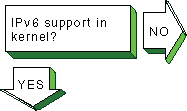
|
Verify that the IPv6 support you want is configured in the kernel.
Enter
the following command:
# sysconfig -s ipv6 | grep configured
If nothing is
displayed, the IPv6 option is not configured in the kernel.
Reconfigure the
kernel by using the
doconfig
command.
See
Section 3.5.1
for more information.
If you want to use configured tunnels, verify that the IP tunneling
support is configured in the kernel.
Enter the following command:
# sysconfig -s iptunnel | grep configured
If
nothing is displayed, the IPTUNNEL option is not configured in the kernel.
Reconfigure the kernel by using the
doconfig
command.
See
Section 3.5.1
for more information.
|
|
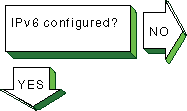
|
Verify that IPv6 is configured to start on system boot by issuing the
rcmgr get IPV6
command.
If IPv6 is configured, the word
yes
is displayed.
If IPv6 is not configured, use the
ip6_setup
utility.
See
Section 3.6
for information on setting up an IPv6
host or router.
|
|
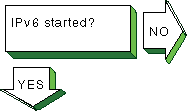
Go to
Section 8.4.1
for IPv6 host problems or
Section 8.4.2
for IPv6 router problems.
|
Verify that IPv6 was started by issuing the following command:
# ping ::1
If
the
host is unreachable
message is displayed, start IPv6
by issuing the following command:
# /usr/sbin/rcinet start inet6
This creates and brings up
the IPv6 interfaces, and starts the IPv6 daemons.
|
8.4.1 Solving IPv6 Host Problems
|
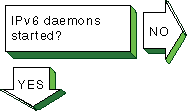
|
Verify that the
nd6hostd
daemon is running by issuing
the following command:
# ps ax | grep nd6hostd
If the daemon is not running, verify
that your system is configured as an IPv6 host by issuing the following command:
# rcmgr get ND6HOSTD
If the word
yes
is not displayed,
run the
ip6_setup
utility and configure your system as
an IPv6 host.
Then, restart IPv6 with the following command:
# /usr/sbin/rcinet restart inet6
If
the word
yes
is displayed, enable debugging for the
nd6hostd
daemon with the following command:
# rcmgr set ND6HOSTD_FLAGS "-d -l /usr/tmp/nd6hostd.log"
Then, restart IPv6.
|
|

|
If a remote node is not known, the following message is displayed:
unknown host
Complete
the following steps:
Verify that the user is using a valid node name to reach the
remote node.
Verify that the remote node is in another name domain and
that the user specified the full domain name.
If your site uses the DNS/BIND name service for name-to-address
translation, look in the
/etc/svc.conf
file to see if
bind
is specified as a service for the
hosts
database entry.
If it is not, configure your system as a DNS/BIND client.
See
Network Administration: Services
for more information.
Verify that your system is running IPv4.
If it is not, use the local
/etc/ipnodes
file for name-to-address translations.
Also, verify that the DNS/BIND service has information about the remote
node.
See the steps for solving DNS/BIND client problems in
Network Administration: Services.
If your site uses only NIS name service for name-to-address
translation, you need to use another service for node names because NIS does
not support IPv6 addresses.
Edit the
/etc/svc.conf
file and add either
bind
(DNS/BIND) or
local
(/etc/ipnodes
file) as the service for the
hosts
database,
depending on which service has the information about the remote node.
If your
/etc/svc.conf
file lists
local
as the only name-to-address translation mechanism, edit the
/etc/ipnodes
file and verify that the node name and address are
present and accurate.
Make any necessary additions or corrections.
Also, verify that there are no formatting errors in previous lines in
the file.
Beginning with the first entry, issue the
ping
command to each node to locate any formatting errors.
|
|

|
If an on-link node is unreachable, one of the following messages is
displayed:
host is unreachable
network is unreachable
timeout
Verify that an on-link host or router, if
one exists, is reachable by using the
ping
command.
If
the command fails or if there are frequently dropped packets, complete the
following steps:
If the node is attached to a LAN, look at the datalink counters
by using the
netstat -I
device
-s
command.
The counters to examine and possible problems are as follows:
Zero blocks sent or received can indicate a network hardware
failure or wiring problem.
High collision rates can indicate an improperly wired network
or a node sending excessive message traffic.
Data overrun and buffer unavailable errors indicate your system
is misconfigured.
Look at the IPv6 and ICMPv6 counters with the
netstat
-p ipv6
and
netstat -p ipv6-icmp
commands, respectively.
The counters and their possible causes:
Packets discarded due to error or errors generated due to
ICMP errors indicate another node generating invalid messages.
Other counters
show more specific information.
Allocation errors can indicate excessive message traffic,
a misconfigured system, or a program that repeatedly allocates memory without
freeing it.
Verify that IPv6 network interfaces exist, are running, and
have
inet6
addresses by using the
ifconfig -a
command.
If they do not, verify that the configuration variables
in the
/etc/rc.config
file are correct.
Run the
ip6_setup
utility to correct any errors.
Also, look for
nd6hostd
errors in the
/var/adm/syslog.dated/current/daemon.log
file.
See
Section 9.8
for more information.
If your interface does not have a global or site-local address, contact
your network administrator to verify that your local router is advertising
a prefix on the link.
If there is no local router, you can define a prefix
by using the
ifconfig
command (see
Section 3.7.5).
Contact the administrator of the on-link system and verify
that the on-link system is up and running, that it is configured for IPv6
correctly, and that the address you are using is enabled on the node's interface.
Issue the
ping
command to the on-link node's
IPv4 address, if IPv4 is configured on both systems.
If this succeeds, verify
the IPv6 configuration on both systems.
If the command fails, see the steps
for solving IPv4 network problems in
Section 8.3.
Issue the
ping
command to other nodes on
the link to determine whether the failure is confined to just one node or
multiple nodes.
Partial connectivity might indicate a faulty network device
or cable on the link.
If the link is a configured tunnel, do the following:
Verify the tunnel source and destination addresses by using
the
ifconfig -a
command.
Contact the administrator of the
tunnel destination node and verify that your source and destination addresses
match the destination and source addresses on that node.
Issue the
ping
command to the tunnel destination
address.
If the command fails, see the steps for solving IPv4 network problems
in
Section 8.3.
|
|

|
If an off-link node is not reachable, one of the following messages
is displayed:
host is unreachable
network is unreachable
timeout
Verify that an off-link node is reachable
by issuing the
ping
command.
If there is 100% packet loss,
complete the following steps:
Verify connectivity between your system and an on-link router
by using the
ping
command.
If the command fails or shows
frequently dropped packets, follow the steps for
[On-link node reachable?].
If you do not know the address to
a router, issue the following command:
# ping -I interface ff02::2
Verify that the interface over which you are sending messages
has a global or site-local unicast address enabled by using the
ifconfig -a
command.
If it does not, contact your network administrator
to verify that your local router is advertising a prefix on the link.
If the link is a configured tunnel and the router is not advertising
an address prefix, manually define one for the tunnel by using the
ip6_setup
utility.
See
Section 3.6.1
for more information.
Contact the remote system's administrator to verify that the
system is up and running, that it is configured for IPv6, and that the IPv6
address on its interface is the same one you are using.
If the address is
different, look in your system's
/etc/ipnodes
file or
have the remote system administrator verify that the DNS entry is correct.
Verify that there is a default route (with U and G flags set)
to a router on the network by issuing the
netstat -rf inet6
command.
If there is not, contact the router administrator to verify that
the router is advertising itself as a default router.
Also, look at other routers to see if your messages are being directed
on the wrong path.
Trace the path to the off-link node by using the
traceroute
command.
See
Section 9.5
and
traceroute(8)
for more information.
If there are frequently dropped packets, the problem might be network
congestion or an intermittent routing problem.
Do the following:
Verify connectivity between your system and an on-link router
by using the
ping
command.
Trace the path to the off-link node by using the
traceroute
command.
See
Section 9.5
and
traceroute(8)
for more information.
|
|

|
If someone reports a problem reaching your node from another node, complete
the following steps:
Verify that their node is reachable by issuing the
ping
command.
If the command fails, follow the steps for
[On-link node reachable?]
or
[Off-link-node reachable?], depending on the location of the
node.
If they are using a name from the DNS database, verify that
the address for your node in the DNS database matches one of the addresses
configured on your system's interfaces.
Use the
nslookup -type=AAAA
node-name
command to retrieve the address from DNS
and the
ifconfig -a
command to display addresses for your
system.
If they are using an address defined in their local
/etc/ipnodes
file, compare that address with the addresses configured
on your system's interfaces.
Use the
ifconfig -a
command.
|
|

|
If a remote node is not configured to accept a connection from your
application, the following message might be displayed:
connection refused
Contact the administrator of the
remote node and ask if the correct socket-based service definitions are defined
in the
/etc/services
and
/etc/inetd.conf
files.
They might be missing or commented out.
Verify that the service in the local
/etc/inetd.conf
file has either
tcp6
or
udp6
in the
protocol field.
|
|


Problem still exists? Report it to your service representative.
See
Chapter 10.
|
If the connection terminates abnormally or a network application appears
to hang, complete the following steps:
Verify that there is network connectivity to the remote node
by using the
ping
command immediately after the failure.
If the
ping
command fails or shows a high rate of
packet loss, follow the steps for either
[On-link node reachable?]
or
[Off-link node reachable?], depending on the location of the
remote node.
If your application transfers a large amount of data over
the network, verify if large or fragmented messages are being handled correctly
by using the
ping -s 2000
nodename
command.
If the
ping
command fails, trace the path to the
remote node with 1200-byte packets by using the
traceroute
nodename
1200
command.
All IPv6 links must support
message sizes of at least 1280 bytes.
This command might show the location
of the problem in the network.
See
Section 9.5
and
traceroute(8)
for more information.
Run the application with different client and server nodes
located on different links in the network.
|
8.4.2 Solving IPv6 Router Problems
|

|
Verify that the
ip6rtrd
daemon is running by issuing
the following command:
# ps ax | grep ip6rtrd
If the daemon is not running, verify
that your system is configured as an IPv6 router by issuing the following
command:
# rcmgr get IP6RTRD
If the word
yes
is
not displayed, run the
ip6_setup
utility and configure
your system as an IPv6 router.
Then, restart IPv6 with the following command:
# /usr/sbin/rcinet restart inet6
If the word
yes
is displayed, enable
debugging for the
ip6rtrd
daemon with the following command:
# rcmgr set IP6RTRD_FLAGS "-d -l /usr/tmp/ip6rtrd.log /etc/ip6rtrd.conf"
Then, restart IPv6.
|
|

|
If a remote node is not known, the following message is displayed:
unknown host
Complete
the following steps:
Verify that the user is using a valid node name to reach the
remote node.
Verify that the remote node is in another name domain and
that the user specified the full domain name.
If your site uses the DNS/BIND name service for name-to-address
translation, look in the
/etc/svc.conf
file to see if
bind
is specified as a service for the
hosts
database entry.
If it is not, configure your system as a DNS/BIND client.
See
Network Administration: Services
for more information.
Verify that your system is running IPv4.
If it is not, use the
/etc/ipnodes
file for name-to-address translation.
Also, verify that the DNS/BIND service has information about the remote
node.
See the steps for solving DNS/BIND client problems in
Network Administration: Services.
If your site uses only NIS name service (yp)
for name-to-address translation, you need to use another service for node
names as NIS does not support IPv6 addresses.
Edit the
/etc/svc.conf
file
and add either
bind
(DNS/BIND) or
local
(/etc/ipnodes
file) as the service for the
hosts
database, depending on which service has the information about
the remote node.
Also, verify that there are no formatting errors in previous lines in
the file.
Beginning with the first entry, issue the
ping
command to each node to locate any formatting errors.
If your
/etc/svc.conf
file lists
local
as the only name-to-address translation mechanism, edit the
/etc/ipnodes
file and verify that the node name and address are
present and accurate.
Make any necessary additions or corrections.
|
|

|
If an on-link node is not reachable, one of the following messages is
displayed:
host is unreachable
network is unreachable
timeout
Verify that an on-link host or router, if
one exists, is reachable by using the
ping
command.
If
the command fails or if there are frequently dropped packets, complete the
following steps:
If the node is attached to a LAN, look at the datalink counters
by using the
netstat -I
device
-s
command.
The counters to examine and possible problems are as follows:
Zero blocks sent or received can indicate a network hardware
failure or wiring problem.
High collision rates can indicate an improperly wired network
or a node sending excessive message traffic.
Data overrun and buffer unavailable errors indicate your system
is misconfigured.
Look at the IPv6 and ICMPv6 counters with the
netstat
-p ipv6
and
netstat -p ipv6-icmp
commands, respectively.
The counters to examine and possible problems are as follows:
Packets discarded due to error or errors generated due to
ICMP errors indicate another node generating invalid messages.
Other counters
show more specific information.
Allocation errors can indicate excessive message traffic,
a misconfigured system, or a program that repeatedly allocates memory without
freeing it.
Verify that IPv6 network interfaces exist, are running, and
have
inet6
addresses by using the
ifconfig -a
command.
If they do not, verify that the
/etc/rc.config
and
/etc/ip6rtrd.conf
files are correct.
Also, look for
ip6rtrd
errors in the
/var/adm/syslog.dated/current/daemon.log
file.
See
Section 9.8
for more information.
Run the
ip6_setup
utility to correct any errors.
Contact the administrator of the on-link system and verify
that the on-link system is up and running, that it is configured for IPv6
correctly, and that the address you are using is enabled on the node's interface.
Issue the
ping
command to the on-link node's
IPv4 address, if IPv4 is configured on both systems.
If this succeeds, verify
the IPv6 configuration on both systems.
If the command fails, see the steps
for solving IPv4 network problems in
Section 8.3.
Issue the
ping
command to other nodes on
the link to determine whether the failure is confined to just one node or
multiple nodes.
Partial connectivity might indicate a faulty network device
or cable on the link.
If the link is a configured tunnel, do the following:
Verify the tunnel source and destination addresses by using
the
ifconfig -a
command.
Contact the tunnel destination
node's administrator and verify that your source and destination addresses
match the destination and source addresses on that node.
Issue the
ping
command to the tunnel destination
address.
If the command fails, see the steps for solving IPv4 network problems
in
Section 8.3.
|
|

|
If an off-link node is not reachable, one of the following messages
is displayed:
host is unreachable
network is unreachable
timeout
Verify that an off-link node is reachable
by issuing the
ping
command.
If there is 100% packet loss,
complete the following steps:
Verify connectivity between your system and the next router
in the path to the off-link node by using the
ping
command.
If the command fails or shows frequently dropped packets, follow the steps
for
[On-link node reachable?].
Verify that the interface over which you are sending messages
has a global or site-local unicast address enabled by using the
ifconfig -a
command.
If it does not, verify that the interface
address prefixes defined in the
/etc/ip6rtrd.conf
file
(see
ip6rtrd.conf(4)) are correct.
Run the
ip6_setup
utility
to correct any prefix errors.
Contact the administrator of the remote system to verify that
the system is up and running, that it is configured for IPv6, and that the
IPv6 address on its interface is the same as the address that you are using.
If the address is different, look in the hosts database.
If there are frequently dropped packets, there might be network congestion
or an intermittent routing problem.
Do the following:
Verify connectivity between your system and an on-link router
by using the
ping
command.
Trace the path to the off-link node by using the
traceroute
command.
See
Section 9.5
and
traceroute(8)
for more information.
|
|

|
IPv6 hosts generate their global and site-local unicast addresses automatically
using address prefixes provided by a router on the link.
If an on-link node
cannot autoconfigure its addresses, complete the following steps:
Verify that the host is reachable from your router by using
the
ping
command and specifying the host's link-local address.
If the command fails or shows a high rate of packet loss, follow the steps
for
[On-link node reachable?].
Edit the
/etc/ip6rtrd.conf
file and verify
that the router is configured to advertise the correct prefixes and that the
timers are reasonable.
See
Section 3.7.11
and
ip6rtrd.conf(4)
for more information.
|
|

|
If another network user reports that message transmission appears to
be failing at your router, complete the following steps:
Obtain the source and destination addresses of the message
that your router is not forwarding.
Then, verify that your router can reach
each node by using the
ping
command.
If either command
fails or shows a high rate of packet loss, follow the steps for
[On-link node reachable?]
or
[Off-link node reachable?], as applicable.
If your router is running the RIPng protocol, verify that
the IPv6 router daemon is running by issuing the following command:
# ps ax | grep ip6rtrd
If it is running, edit the
/etc/ip6rtrd.conf
file and verify that the RIPng protocol is enabled on each IPv6
link.
If it is not, your node might not be propagating routes correctly.
Make sure that you are not using manual routes on some interfaces
and RIPng routes on other interfaces.
Manual routes defined in the
/etc/routes
file do not get propagated to other routers with RIPng.
|
|

|
If someone reports a problem reaching your node from another node, complete
the following steps:
Verify that their node is reachable by issuing the
ping
command.
If the command fails, follow the steps for
[On-link node reachable?]
or
[Off-link-node reachable?], depending on the location of the
node.
If they are using a name from the DNS database, verify that
the address for your node in the DNS database matches one of the addresses
configured on your system's interfaces.
Use the
nslookup -type=AAAA
node-name
command to retrieve the address from DNS
and the
ifconfig -a
command to display addresses for your
system.
If they are using an address defined in their local
/etc/ipnodes
file, compare that address with the addresses configured
on your system's interfaces.
Use the
ifconfig -a
command.
|
|

|
If a remote node is not configured to accept a connection from your
application, the following message might be displayed:
connection refused
Contact the administrator of the
remote node and ask if the correct socket-based service definitions are defined
in the
/etc/services
and
/etc/inetd.conf
files.
They might be missing or commented out.
Verify that the service in the local
/etc/inetd.conf
file has either
tcp6
or
udp6
in the
protocol field.
|
|


Problem still exists? Report it to your service representative.
See
Chapter 10.
|
If the connection terminates abnormally or a network application appears
to hang, complete the following steps:
Verify that there is network connectivity to the remote node
by using the
ping
command immediately after the failure.
If the
ping
command fails or shows a high rate of
packet loss, follow the steps for either
[On-link node reachable?]
or
[Off-link node reachable?], depending on the location of the
remote node.
If your application transfers a large amount of data over
the network, verify if large or fragmented messages are being handled correctly
by using the
ping -s 2000
nodename
command.
If the
ping
command fails, trace the path to the
remote node with 1200-byte packets by using the
traceroute
nodename
1200
command.
All IPv6 links must support
message sizes of at least 1280 bytes.
This command might show the location
of the problem in the network.
See
Section 9.5
and
traceroute(8)
for more information.
Run the application with different client and server nodes
located on different links in the network.
|
8.5 Solving ATM Problems
|

|
Verify that the ATM subsets are installed.
Enter the following command:
# setld -i | grep OSFATM
The following messages are displayed:
OSFATMnnn installed ATM Commands
(Network-Server/Communications)
OSFATMBINnnn installed ATM Kernel
Modules (Kernel Build Environment)
OSFATMBINCOMnnn installed ATM Kernel
Header and Common Files
(Kernel Build Environment)
OSFATMBINOBJECTnnn installed ATM Kernel
Objects (Kernel Software Environment)
If the
OSFATM,
OSFATMBIN, and
OSFATMBINCOM
subsets are not installed, install them by using the
setld
command.
See the
Installation Guide
for information on installing
the subset.
|
|

|
Verify that the ATM support you want is configured in the kernel.
Enter
the following command:
# sysconfig -q atm
If nothing is displayed, ATM is
not configured in the kernel.
Reconfigure the kernel with the ATM option
and additional ATM options as needed.
See
Section 4.2.2
for
a list of ATM kernel options and for information on reconfiguring the kernel.
If ATM is configured in the kernel, use the
sysconfig -q
command to verify that other ATM kernel options are configured.
Reconfigure
the kernel with additional options as needed.
|
|

Go to
Section 8.5.1
for Classical IP, go to
Section 8.5.2
for LAN Emulation, or go to
Section 8.5.3
for IP switching.
|
Verify that the driver is configured by using the
atmconfig
drvlist
command.
If the driver is configured, information similar
to the following is displayed:
Name: lta0 Type: STS-3 State: UP
Driver ID: 1 ESIs: 8 PPAs: 9 VCs: 6
If an entry for the driver does not exist, use the
genvmunix
kernel to reboot the system and run the
doconfig
utility to build a kernel with the required driver.
If the driver state is not
UP, run the
atmsetup
utility for the ATM service you want.
See
Section 4.3.2.4,
Section 4.3.3.3, and
Section 4.3.4.2
for information
on configuring the driver for Classical IP (CLIP), LAN emulation (LANE), and
IP switching, respectively.
|
8.5.1 Solving CLIP Problems
|

|
Verify that signaling is configured.
Enter the following command:
# atmsig status driver=driver_name
If the UNI version number is
not displayed or the ILMI state is
Unknown, run the
atmsetup
utility and configure signaling.
See
Section 4.3.2.4
for information.
|
|

|
Verify that the CLIP
lis
interfaces are created.
Enter the following command:
# atmarp -h
If a
lis
interface is created,
the status of all created LISs and data indicating whether the host is an
ARP client or ARP server is displayed.
If no LISs are created, run the
atmsetup
utility
and configure CLIP.
See
Section 4.3.2.4
for more information.
|
|

|
Verify that a
lis
interface is configured.
Enter
the following command:
# ifconfig lisx
If a
lis
interface is configured, information similar to the following
is displayed:
lis0: flags=c23<UP,BROADCAST,NOTRAILERS,MULTICAST,SIMPLEX>
inet 10.140.120.52 netmask ffffff00 broadcast 10.140.120.255
ipmtu 1500
If a
lis
interface is not configured, run the
netconfig
utility to configure one or use the Interfaces application
from the SysMan Menu.
See
Section 4.3.2.5
for more information.
|
|

|
If a remote host is not known, the following message is displayed:
unknown host
Complete
the following steps:
Verify that the user is using a valid host name to reach the
remote host.
Verify that the remote host is in another name domain and
that the user specified the full domain name.
If your site uses DNS for name-to-address translation, look
in the
/etc/svc.conf
file to see if
bind
is specified as a service for the
hosts
database entry.
If it is not, edit the file and add it.
Also, verify that DNS has information about the remote host.
See the
steps for solving DNS/BIND client problems in
Network Administration: Services.
If your site uses NIS name service for name-to-address translation,
look in the
/etc/svc.conf
file to see if
nis
is specified as a service for the
hosts
database entry.
If it is not, edit the file and add it.
Also, verify that the NIS service has information about the remote host.
See the steps for solving NIS client problems in
Network Administration: Services.
If your
/etc/svc.conf
file lists
local
as the only name-to-address translation mechanism, the
/etc/hosts
file does not have information on the remote host.
See
System Administration
for more information.
|
|

|
If a remote host is not reachable, the following message is displayed:
host is unreachable
Complete
the following steps:
Verify that the cabling between the local host and the switch
is properly installed and undamaged.
Verify that there is network connectivity to the IP controller
on the switch by using the
ping
command.
If the command
fails, it might be because the
ifconfig
command parameters
are wrong, or the IP controller is down or has an interface problem.
Contact
the switch administrator.
Verify that there is network connectivity to the target remote
host by using the
ping
command.
If the command fails, use
the
traceroute
command to verify the route to the remote
host.
|
|


Problem still exists? Report it to your service representative.
See
Chapter 10.
|
If the connection terminates abnormally, complete the following steps:
Test the network to determine whether the problem is on the
local host, remote host, or a host on the path between the two.
See
Section 8.3.
After you identify the host with the problem, do the following:
Confirm that the network device is properly configured.
Verify
that the broadcast address and address mask for the local host are correct.
See
Section 2.3
for information on configuring network devices.
Make sure the local host's
hosts
database
has the correct IP addresses.
Make sure the cabling from the local host to the network is
intact and properly connected.
If connected over a LAN, verify that the ARP entries are correct
and that the system is properly connected to the LAN.
|
8.5.2 Solving LANE Problems
|

|
Verify that signaling is configured.
Enter the following command:
# atmsig status driver=driver_name
If no User-Network Interface
(UNI) version number is displayed or the Integrated Layer Management Interface
(ILMI) state is
Unknown, run the
atmsetup
utility and configure signaling.
See
Section 4.3.3.3
for information.
|
|

|
Verify that an
elan
interface is created.
Enter the
following command:
# atmelan show
If an
elan
interface is
created, information similar to the following is displayed:
.
.
.
control state: S_OPERATIONAL
.
.
.
If the control state is not
S_OPERATIONAL,
do the following:
Increase the message logging level for the
lane
subsystem.
See
Section 4.4.6
for more information.
Verify that the UNI version on the switch matches the UNI
version on your system.
Verify that the LAN Emulation Server (LES) on the switch is
configured correctly.
|
|

|
Verify that an
elan
interface is configured.
Enter
the following command:
# ifconfig elanx
If an
elan
interface is configured, information similar to the following
is displayed:
elan0: flags=c23<UP,BROADCAST,NOTRAILERS,MULTICAST,SIMPLEX>
inet 10.140.120.52 netmask ffffff00 broadcast 10.140.120.255
ipmtu 1500
If an
elan
interface is not configured, run the
netconfig
utility to configure one or use the Interfaces application
from the SysMan Menu.
See
Section 4.3.3.4
for more information.
|
|

|
If a remote host is not known, the following message is displayed:
unknown host
Complete
the following steps:
Verify that the user is using a valid host name to reach the
remote host.
Verify that the remote host is in another name domain and
that the user specified the full domain name.
If your site uses DNS for name-to-address translation, look
in the
/etc/svc.conf
file to see if
bind
is specified as a service for the
hosts
database entry.
If it is not, edit the file and add it.
Also, verify that DNS has information about the remote host.
See the
steps for solving DNS/BIND client problems in
Network Administration: Services.
If your site uses NIS name service for name-to-address translation,
look in the
/etc/svc.conf
file to see if
nis
is specified as a service for the
hosts
database entry.
If it is not, edit the file and add it.
Also, verify that the NIS service has information about the remote host.
See the steps for solving NIS client problems in
Network Administration: Services.
If your
/etc/svc.conf
file lists
local
as the only name-to-address translation mechanism, the
/etc/hosts
file does not have information on the remote host.
See
System Administration
for more information.
|
|

|
If a remote host is not reachable, the following message is displayed:
host is unreachable
Complete
the following steps:
Verify that the cabling between the local host and the switch
is properly installed and undamaged.
Verify that the addresses on the link are correct by using
the
ifconfig elanx
command.
Verify that there is network connectivity to the target remote
host by using the
ping
command.
If the command fails, use
the
traceroute
command to verify the route to the remote
host.
|
|


Problem still exists? Report it to your service representative.
See
Chapter 10.
|
If the connection terminates abnormally, complete the following steps:
Test the network to determine whether the problem is on the
local host, remote host, or a host on the path between the two.
See
Section 8.3.
After you identify the host with the problem, do the following:
Confirm that the network device is properly configured.
Verify
that the broadcast address and address mask for the local host are correct.
See
Section 2.3
for information on configuring network devices.
Make sure the local host's
hosts
database
has the correct IP addresses.
Make sure the cabling from the local host to the network is
intact and properly connected.
If connected over a LAN, verify that the ARP entries are correct
and that the system is properly connected to the LAN.
|
8.5.3 Solving IP Switching Problems
|

|
Verify that an IP switching
ips
interface is created.
Enter the following command:
# atmifmp showips
If an
ips
interface
is created, information similar to the following is displayed for each created
ips
interface:
ips0:
Attached to driver lta0
Default (SNAP) VC = 32
IP Traffic VC = 1850 (Unused - peer does
not support Flow Type 0)
Min Tx VC = 1
Max Tx VC = 2048
Min Rx VC = 1
Max Rx VC = 2048
Driver Min Tx VC = 1
Driver Max Tx VC = 2048
Driver Min Rx VC = 1
Driver Max Rx VC = 2048
Peer does not support Flow Type 0
This example
shows that the
ips0
interface was created and is attached
to driver
lta0.
If no
ips
interfaces are found, create one or more
ips
interfaces.
See
Section 4.3.4
for more information.
|
|

|
Verify that an
ips
interface is configured.
Enter
the following command:
# ifconfig ipsx
If an
ips
interface is configured, information similar to the following
is displayed:
ips0: flags=4d1<UP,POINTOPOINT,RUNNING,NOARP,MULTICAST>
inet 16.142.128.129 --> 16.142.128.130 netmask fffffffc ipmtu 1500
The example shows that the interface is up and running and that addresses
are configured for each end of the point-to-point link.
If an
ips
interface is not configured, run the
netconfig
utility to configure one or use the Interfaces application
from the SysMan Menu.
See
Section 4.3.4.3
for more information.
|
|

|
If a remote host is not known, the following message is displayed:
unknown host
Complete
the following steps:
Verify that the user is using a valid host name to reach the
remote host.
Verify that the remote host is in another name domain and
that the user specified the full domain name.
If your site uses the DNS for name-to-address translation,
look in the
/etc/svc.conf
file to see if
bind
is specified as a service for the
hosts
database
entry.
If it is not, edit the file and add it.
Also, verify that DNS has information about the remote host.
See the
steps for solving DNS/BIND client problems in
Network Administration: Services.
If your site uses NIS name service for name-to-address translation,
look in the
/etc/svc.conf
file to see if
nis
is specified as a service for the
hosts
database entry.
If it is not, edit the file and add it.
Also, verify that the NIS service has information about the remote host.
See the steps for solving NIS client problems in
Network Administration: Services.
If your
/etc/svc.conf
file lists
local
as the only name-to-address translation mechanism, the
/etc/hosts
file does not have information on the remote host.
See
System Administration
for more information.
|
|

|
If a remote host is not reachable, the following message is displayed:
host is unreachable
Complete
the following steps:
Verify that the addresses on the point-to-point link to the
switch are correct by using the
ifconfig ipsx
command.
Verify the connection to the IP controller on the switch by
using the
ping
command.
If the command fails, the local
host's
ifconfig
command parameters might be incorrect.
On the switch, the problem might be that the IP controller is down or has
an interface problem.
Contact the switch administrator.
Verify that there is an
ips
route to the
remote host's subnet by using the
netstat -r
command.
|
|

|
If the
ping
command fails, complete the following
steps:
Verify that the cabling between the local host and the switch
is properly installed and undamaged.
Verify that the default Subnetwork Attachment Point (SNAP)
virtual circuit (VC) specified on the local host matches the default SNAP
VC on the switch.
Contact the administrator of the remote system and verify
that the remote system is up and running and that it is configured correctly
for IP switching.
Verify the route to the remote host by using the
traceroute
command.
If the first hop in the output shows the default
network interface and not the IP controller, add a static route to the remote
subnet through the IP controller to your routing table.
Use the
netstat -r
command to verify the change.
If the route reaches the IP controller but goes no further, contact
the administrator of the remote system to verify that the system is configured
correctly and that the routing tables are correct.
|
|


Problem still exists? Report it to your service representative.
See
Chapter 10.
|
If the connection terminates abnormally, complete the following steps:
Test the network to determine whether the problem is on the
local host, remote host, or a host on the path between the two.
See
Section 8.3.
After you identify the host with the problem, do the following:
Confirm that the network device is properly configured.
Verify
that the broadcast address and address mask for the local host are correct.
See
Section 2.3
for information on configuring network devices.
Make sure the
hosts
database on the local
host has the correct IP addresses.
Make sure the cabling from the local host to the network is
intact and properly connected.
|
8.6 Solving DHCP Problems
|

|
Verify that the Additional Networking Services subset is installed.
Enter the following command:
# setld -i | grep OSFINET
If the subset is installed, the following message is displayed:
OSFINETnnn installed Additional Networking Services
(Network-Server/Communications)
If the subset is
not installed, install it by using the
setld
command.
See the
Installation Guide
for more information on installing the subset.
|
|
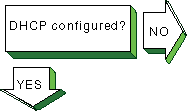
|
Complete the following steps to verify that Dynamic Host Configuration
Protocol (DHCP) has been configured on both server and client:
Use the
rcmgr
utility to display the value
of the
JOIND
entry in the
/etc/rc.config.common
file on the DHCP server:
# rcmgr get JOIND
If nothing is returned, run the SysMan Menu
utility to configure your DHCP server.
See
Section 5.3.7
for more information.
Use the
rcmgr
utility to display the value
of the
IFCONFIG_n
entry in the
/etc/rc.config
file on the DHCP client.
For example:
# rcmgr get IFCONFIG_0
A value
similar to the following is displayed:
DYNAMIC netmask n.n.n.n
If a similar value is not returned, run the SysMan Menu utility
to configure your DHCP client.
See
Section 2.3
for more
information.
|
|

|
Verify that the DHCP server is running and reachable, using the
ping
command.
|
|

|
Verify that the DHCP daemon (joind) is running on
the server.
Enter the following command:
# ps -e | grep joind
Alternatively, you can use the SysMan Menu utility to view the status
of the DHCP daemon.
You can skip directly to the status dialog box by entering
the following command:
# /usr/sbin/sysman dmnstatus
If the DHCP daemon is not running, start it by entering the following
command:
# /usr/sbin/joind
|
|


Problem still exists? Report it to your service representative.
See
Chapter 10.
|
If a DHCP client has problems obtaining DHCP information from the server,
do the following:
Verify the Media Access Control (MAC) address you entered
for the client.
Users of Microsoft clients specifically must see
Section 5.3.5,
which explains how these clients modify their MAC addresses before sending
them to the DHCP server.
Run the
joind
daemon with the debugging
flag by doing the following:
Stop the
joind
daemon with the
kill -HUP
command.
Caution
Never use the
kill -9
command to stop the DHCP
server daemon; it can corrupt your database files.
Restart the
joind
daemon with the debug
flag as follows:
# /usr/sbin/joind -d4
If you are running
joind
from the
/etc/inetd.conf
file, do the following:
Edit the
/etc/inetd.conf
file and add the
-d4
flag.
Stop the
joind
daemon with the
kill -HUP
command.
Stop the
inetd
daemon with the
inetd -h
command.
This forces the
inetd
daemon
to reread the
/etc/inetd.conf
file.
Alternatively, you can run the SysMan Menu utility to configure
your DHCP server with the debug option.
See
Section 5.3.7
for more information.
Review the
/var/join/log
file for information
about the cause of any DHCP client problems.
The following example shows a
/var/join/log
file
message that indicates a DHCP discover message arrived at the server system,
but the IP subnetwork address range is not defined:
DHCPDISCOVER from HW address 08:00:2b:96:79:b6 :
network not administered by server
This problem can also occur if an address range is defined, but the
/etc/join/netmasks
file is missing the subnetwork mask definition
for this IP network.
In this case, edit the netmasks file, add an entry for
the subnetwork, and restart the DHCP server,
/usr/sbin/joind.
|
8.7 Solving SLIP Problems
|
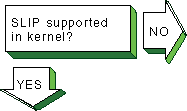
|
Verify that the correct number of Serial Line Internet Protocol (SLIP)
pseudodevices are supported in the kernel by using the
netstat -in
command.
If SLIP is supported, information similar to the following
is displayed for each interface:
sl0* 296 <Link> 0 0 0 0 0
The
sl
prefix indicates that
SLIP is supported on the system.
In this example there is one SLIP interface.
If you need additional SLIP interfaces, specify them by adding the
nslip=x
attribute under the
net: subsystem in the
/etc/sysconfigtab
file.
See
System Administration
for information on adding more SLIP interfaces.
On systems with 24 MB of memory, SLIP is not configured into the kernel.
To add SLIP into the kernel, edit the system configuration file (/usr/sys/confhostname) and add the following
entry:
options SL
See
System Administration
for more information.
|
|

|
Configure the network hardware as follows:
|
|

|
If a remote system cannot dial in to your system successfully, complete
the following steps:
Check the
/usr/spool/locks
directory for
LCK..ttynn
lock files.
If any exist
for the terminal device you are using for SLIP, remove them.
When you establish a connection over a terminal device, the system generates
a lock file to prevent the connection from being disrupted by another application.
If the connection terminates abnormally, the lock file might persist, preventing
you from establishing new connections.
Edit the
/etc/slhosts
file and include
the
debug
option in the login entry for the host that cannot
log in.
See
slhosts(4)
for more information.
Instruct the remote user to dial in again.
Look in the
/var/adm/syslog.dated/current/daemon.log
file for information on SLIP problems on the dial-in system.
See
Section 9.8
for more information.
|
|

|
If you cannot dial out to the remote system, complete the following
steps:
Check the
/usr/spool/locks
directory for
LCK..ttynn
lock files.
If any exist
for the terminal device you are using for SLIP, remove them.
When you establish a connection over a terminal device, the system generates
a lock file to prevent the connection from being disrupted by another application.
If the connection terminates abnormally, the lock file might persist, preventing
you from establishing new connections.
Verify that the modem is working correctly.
Edit the
/etc/acucap
file and include the
db
option in your modem's entry.
This option displays useful information
for debugging a new entry.
See
acucap(4)
for more information.
Verify SLIP setup.
Do the following:
Edit the
startslip
dial-out script file
and specify the
debug
subcommand and a debug log file.
Try to dial out again.
Look in the debug log file for information about SLIP dial-out
problems.
|
|

|
If you cannot communicate with the remote host and none of the debug
messages shows an error, complete the following steps:
Verify that the IP addresses and netmasks are correct on both
ends of the connection.
Examine the following SLIP configuration parameters at each
end of the connection:
Internet Control Message Protocol (ICMP) traffic suppression --
If enabled at either end of the connection, the
ping
command
will fail.
TCP header compression -- If enabled at one end, TCP
header compression must be enabled or autoenabled on the other end.
|
|

|
If you can communicate with the remote host but not the network connected
to the remote host, complete the following steps:
If your local system is using the remote system as a gateway
system, issue the
netstat -rn
command on the local
system to verify that the remote SLIP address is the default gateway.
On the gateway system (remote system), issue the
iprsetup -d
command to see if the
ipforwarding
and
ipgateway
variables are on.
If the variables are off,
use the
iprsetup -s
command to turn them on.
On the gateway system, verify that the
gated
daemon is running.
See
gated(8)
for more information.
|
|


Problem still exists? Report it to your service representative.
See
Chapter 10.
|
If the
startslip
command does not complete successfully,
complete the following steps:
Build your kernel with the
PACKETFILTER
option.
Use the
tcpdump
command to examine packets
sent and received through the SLIP interface.
See
tcpdump(8)
for more information.
|
8.8 Solving PPP Problems
|

|
Verify that the Point-to-Point Protocol (PPP) is supported in the kernel
by using the
sysconfig -s | fgrep ppp
command.
If PPP is
supported, information similar to the following is displayed:
ppp: loaded and configured
If PPP is not supported, add options
PPP
into the
/sys/conf/MACHINE
system configuration
file and rebuild the kernel.
|
|

|
Configure the network hardware as follows:
Direct connections to remote host -- Use a null modem
or modem eliminator cable to connect your system to the remote host.
Phone line connection to remote host -- Use a cable to
connect your system to a modem and another cable to connect your modem to
a phone line.
The modem you use must be compatible with the modem at the
remote host.
Make sure the modem is configured as follows:
|
|

|
If you are logging messages to the console and the link comes up successfully,
the following messages are displayed on the console:
Local IP address: xx.xx.xx.xx
Remote IP address: yy.yy.yy.yy
If
the link does not come up, look at the following:
Check the
/usr/spool/locks
directory for
LCK..ttynn
lock files.
If any exist
for the terminal device you are using for PPP, remove them.
When you establish a connection over a terminal device, the system generates
a lock file to prevent the connection from being disrupted by another application.
If the connection terminates abnormally, the lock file might persist, preventing
you from establishing new connections.
Verify that the serial connection is set up successfully.
Use the
chat -v
command to log the characters the
chat
program sends and receives.
Verify that the
pppd
daemon starts on the
remote system.
Use the
chat -v
command to log the
characters the
chat
program sends and receives.
Examine the PPP negotiation between the two peers.
Use the
pppd
command with the
debug
option to log the
contents of all control packets sent and received.
|
|


Problem still exists? Report it to your service representative.
See
Chapter 10.
|
If network applications do not work successfully, this might indicate
a problem with assigning IP addresses or routing.
Do the following:
Use the
netstat -i,
netstat -r,
ping, and
traceroute
commands
to diagnose the problem.
If you can communicate with the peer machine but not with
machines beyond that in the network, there is a routing problem.
For instances
where the local machine is connected to the Internet through the peer, do
the following:
Assign the local machine an IP address on the same subnet
as the remote machine.
Run the local
pppd
daemon with the
defaultroute
option.
Run the remote
pppd
daemon with the
proxyarp
option.
On the peer system (remote system), issue the
iprsetup -d
command to determine if the
ipforwarding
and
ipgateway
variables are on.
If these variables are off, use the
iprsetup -s
command to turn them on.
|
8.9 Solving LAT Problems
|

|
Verify that the Local Area Transport subset is installed.
Enter the
following command:
# setld -i | grep OSFLAT
If the subset is installed,
the following message is displayed:
OSFLATnnn installed Local Area Transport (LAT)
(General Applications)
If the subset is not installed,
install it by using the
setld
command.
See the
Installation Guide
for information on installing the subset.
|
|
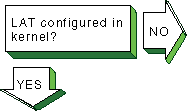
|
Verify that Local Area Transport is configured in the kernel.
Enter
the following command:
# sysconfig -q lat
If no information is displayed,
LAT is not configured in the kernel.
Reconfigure the kernel with the LAT
option.
See
System Administration
for information on reconfiguring the kernel.
|
|

|
Use the
rcmgr
utility to display the value of the
LAT_SETUP
entry in the
/etc/rc.config
file:
# rcmgr get LAT_SETUP
If 0 is returned, run the
latsetup
utility.
See
Section 7.3.1
for more information.
|
|

|
If the
latsetup
utility fails while creating new
LAT ttys, verify that the
/usr/sbin
directory is included
in the search path.
Enter the following command:
# echo $PATH
If it is not,
include it in your
PATH
environment variable.
Then, create
new LAT ttys using the
latsetup
command.
|
|

|
Verify that LAT has been started.
Enter the following command:
# latcp -d
If
LAT is running, the following line is displayed:
LAT Protocol is active
If LAT was not started, start it.
Enter the following
command:
# latcp -s
|
|

|
If LAT starts and messages are continually displayed on the system console,
look for the following messages and perform the required steps:
Message 1
getty: cannot open "/dev/lat/xx".
errno: 2
This means a LAT terminal device file (tty)
does not exist and the
/etc/inittab
file contains an entry
for this file.
The
latsetup
utility will also report that
no LAT entries are available.
Do the following:
Edit the
/etc/inittab
file and remove the
LAT
getty
entries.
If LAT terminal devices are required, create the LAT terminal
device files and corresponding entries in the
/etc/inittab
file by using the
latsetup
command.
See
latsetup(8)
for information.
Message 2
getty: cannot open "/dev/lat/xx".
errno: 19
This means the kernel was not configured
with the LAT option and the
/etc/inittab
file contains
at least one LAT
getty
entry.
Do either of the following:
Configure LAT into the kernel.
See
System Administration
for information
on configuring LAT into the kernel.
Remove the LAT
getty
entries from the
/etc/inittab
file, either manually or by using the
latsetup
command.
Message 3
INIT: Command is respawning too rapidly.
The following
meanings are possible:
You are using an optional service name, such as
lattelnet, and it is incorrectly defined.
Do the following:
Verify that the optional service name defined by the
latcp -A
command is correct by using the
latcp -d
command.
Edit the
/etc/inittab
file and verify that
a LAT entry has the optional service name specified correctly.
An attempt was made to use a nonexistent LAT terminal device
(tty).
Do the following:
Edit the
/etc/inittab
file and remove the
entry with the nonexistent terminal device name.
If LAT terminal devices are required, create the LAT terminal
device files and corresponding entries in the
/etc/inittab
file by using the
latsetup
command.
See
latsetup(8)
for more information.
|
|

|
If the user cannot connect to or display a service from a terminal server
via LAT, complete the following steps on the system:
Verify that the service name is correct by using the
latcp -d
command.
If the service name is incorrect, delete the
service with the incorrect name.
Enter the following command:
# latcp -D -aservice_name
Then, add a service with the correct name.
Enter the following command:
# latcp -A -aservice_name
See
latcp(8)
for more information.
Display the group codes for the service to which the user
is attempting to connect, using the
latcp -d
command.
Check if any group code matches a group displayed by using the
show
port
command at the terminal server.
If no group code matches, do
either of the following:
Add at least one group displayed by the port to the service.
Enter the following command:
# latcp -glist -aservice_name
Change the port characteristics at the terminal server by
adding a group that matches the service.
See
latcp(8)
for more information.
Check if LAT is started on the system.
If it is not, start
it.
Enter the following command:
# latcp -s
If the problem persists, restart LAT.
Enter the following
command:
# latcp -s
|
|

|
If problems occur when using an optional service, complete the following
steps:
Verify that the service was added as an optional service.
Enter the following command:
# latcp -d
Look for the following line:
Service name: name (Optional)
If
Optional
is not displayed, the optional service was not defined
with the
-o
option.
Delete the service.
Enter the
following command:
# latcp -D -aservice_name
Then, add the service with the correct name and the
-o
option.
Enter the following command:
# latcp -A -aservice_name -o
See
latcp(8)
for more information.
Verify that the optional service name matches the name defined
in the
/etc/inittab
file.
If it does not, do either of
the following:
Edit the
/etc/inittab
file and specify
the optional service name.
Delete the service.
Enter the following command:
# latcp -D -aservice_name
Then, add the service with the correct
name and the
-o
option.
Enter the following command:
# latcp -A -aservice_name -o
See
latcp(8)
for more information.
|
|

|
If the user cannot connect to a host using LAT, the following messages
are displayed:
Connection
to node-name not established.
Service in use.
The
/etc/inittab
file does not contain a sufficient
number of
getty
entries.
Create more LAT terminal devices
(ttys) and add their corresponding entries into the
/etc/inittab
file by using the
latsetup
command.
Then, restart
LAT to advertise the available services.
Enter the following command:
# latcp -s
See
Section 7.3.1
for information.
|
|

|
If a host-initiated connection fails, verify that the port, host, and
service names are specified correctly.
Enter the following command:
# latcp -d -P -L
If these names are not specified correctly, delete the
application ports with the incorrect names.
Enter the following command:
# latcp -D -pport_name
Then, add the application ports,
using correct spelling.
To create the application port by specifying the remote
port to which the LAT terminal device is to be mapped, use the following command:
# latcp -A -plocal_port -Hnode -Rrem_port
Or, to create the application port by specifying the remote service name to
which the LAT terminal device is to be mapped, use the following command:
# latcp -A -plocal_port -Hnode -Vsvc_name
See
latcp(8)
for information.
Note
When you delete an application port for a LAT printer, any print operations
that are currently executing continue until the printer buffer is empty.
The
print job might not be complete.
|
|

|
If you print a file to a printer attached to a LAT application port,
the printer is online, and no printing occurs, look at the status of the print
queue.
Enter the following command:
# lpc status
The following line
might be displayed:
waiting for printer to become ready (offline ?)
If
this line is displayed, verify that LAT has been started.
Enter the following
command:
# latcp -d
If LAT has not been started, start it.
Enter the following command:
# latcp -s
|
|
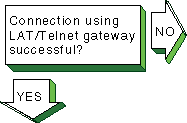
|
If problems are encountered with the LAT/Telnet gateway, look in the
/var/adm/syslog.dated/current/daemon.log
file for error messages.
Use the error messages to diagnose the problem.
See
Section 9.8
for more information on viewing the
daemon.log
file.
The
lattelnet
utility uses the syslog message priority
of LOG_INFO.
For example, if you edit a LAT terminal entry in the
/etc/inittab
file, reassign it to
lattelnet
while
a
getty
process is still active for the terminal, and a
user tries to connect to LAT/Telnet, the connection will fail.
The following
error message is posted in the
daemon.log
file:
No such file or directory
Terminate the
getty
process for the terminal port.
|
|


Problem still exists? Report it to your service representative.
See
Chapter 10.
|
If the LAT connection terminates abnormally, complete the following
steps:
Examine the LAT terminal device (ttys) files for duplicate
minor numbers.
Enter the following command:
# ls -l /dev/lat/*
If any exist, remove the duplicate device files, leaving the original file.
Look in the
/etc/inittab
file for duplicate
LAT entries.
Remove the duplicate entries, leaving the original entry.
|